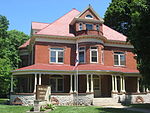Camp Sherman, Ohio
1917 establishments in OhioBuildings and structures in Chillicothe, OhioInstallations of the United States Army National GuardMilitary installations established in 1917Military installations in Ohio ... and 4 more
Ohio National GuardOhio building and structure stubsUnited States Army stubsUnited States military history stubs

Camp Sherman is an American military training site near Chillicothe, Ohio. It was established in 1917 after the United States entered World War I. It now serves as a training site for the Ohio Army National Guard.
Excerpt from the Wikipedia article Camp Sherman, Ohio (License: CC BY-SA 3.0, Authors, Images).Camp Sherman, Ohio
SR 104, Chillicothe
Geographical coordinates (GPS) Address Phone number Website Nearby Places Show on map
Geographical coordinates (GPS)
| Latitude | Longitude |
|---|---|
| N 39.3680556 ° | E -83.0008333 ° |
Address
Chillicothe Correctional Institution
SR 104 15802
45601 Chillicothe
Ohio, United States
Open on Google Maps









